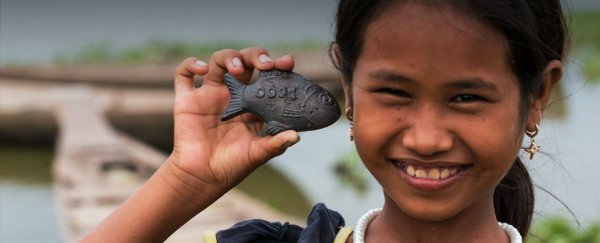Anaemia is the most common and widespread nutritional disorders in the world, affecting 2 billion people globally - or over 30 percent of the world's population. But Canadian scientists have come up with an ingenius solution, and it's so simple, it fits in the palm of your hand.
Meet the Lucky Iron Fish - a chunk of iron that's thrown into the saucepan and boiled with lemon to give adults 75 percent of their daily recommended iron intake, and close to 100 percent for kids.
The idea came to University of Guelph public health researcher, Christopher Charles, during a trip to Cambodia six years ago, when he realised how widespread anaemia was. He saw the disorder was stunting the children's development and leaving the women so tired they were unable to work.
Iron tablets weren't working, as they were hard to distribute and left locals with unpleasant side effects, writes Philippa Roxby for BBC Health. With previous research showing that cooking in an iron pan increased the iron content of food, Charles decided to make lumps of iron that the locals could boil to increase their iron intake.
Shaped like little smiling fish - a symbol of luck in Cambodian culture - these inexpensive iron lumps are about 7.5 centimetres long and weigh 200 grams. What makes them special is that when they're heated up in a pan, they release iron at exactly the right concentration to provide the majority of the local's recommended daily iron intake. The recipe is simple: boil the fish in water or soup for 10 minutes, remove from the heat, and add a generous dash of lemon juice to foster iron absorption.
 Credit: Lucky Iron Fish
Credit: Lucky Iron Fish
So far, the results look positive, with 50 percent of Cambodian villagers in a trial cured of anaemia after 12 months of using the fish. It's crucial for the success for the project that the fish be deemed culturally acceptable, and they seem to be getting the tick from locals. A mother from the Preah Vihear province, who is participating in one of the trials, told the BBC, "I'm happy, the blood test results show that I have the iron deficiency problem, so I hope will be cured and will be healthy soon. I think all the people in Sekeroung village will like the fish, because fish is our everyday food."
The fish are now being used by about 2,500 Cambodian families and another 9,000 fish have been distributed to hospitals and charity organisations around the country.
Being deficient in iron means the body doesn't produce enough red blood cells, which are vital to carry oxygen around the blood. A shortage can mean our organs and tissues are oxygen-deprived, making us tired, pale and more vulnerable to illness. It hits women and children the hardest, with almost 50 percent in the developing world being diagnosed with anaemia.
In terms of preventing this, one of the major hurdles is that there are different types of anaemia, and the disorder can be caused by a multitude of things, such as vitamin deficiencies and parasitic infections. It can also be tough to measure iron deficiency in the developing world, making accurate statistics a near-impossibility.
Suffice it to say, it's a big problem that Charles says is caused in Cambodia by what the locals eat. "They have a really poor diet - a big plate of white rice and maybe a small cut of fish," he told Roxby at the BBC. "That's their two meals a day. And it's just not meeting their nutritional requirements."
Next on the agenda for the Lucky Iron Fish project is to distribute the fish just about everywhere, including countries like Australia, Canada and the US. While perhaps not as necessary, experts say it'd do us no harm.
